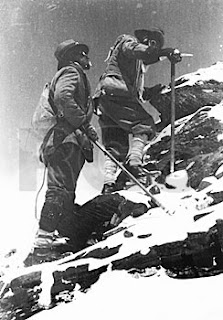Anderson & Company, The Shetland Warehouse Est. 1872
I will be completing the Trek wearing as much authentic Shetland clothing as possible, rather than modern day synthetics, as I trek higher the early morning temperature will begin to drop and on reaching my goal at base camp the temperature will have dropped to minus 11 degrees c with the added wind chill any where between -14 to -30 degrees
I am getting my clothing from Anderson and co in Shetland who use locals to hand knit garments from the authentic Everest wool, they are Also supplying gifts for the Sherpas and porters who will accompany our group on the trek
A brief history of Shetland wools connection with Everest is included below
In 1952, a Shetland Knitwear firm, T.M. Adie and Sons of Voe , was commissioned by the London outfitters of Captain Hunt's British Everest Expedition to develop a garment for their expedition team.
The clothing had been carefully planned and a lightweight garment with high heat retaining qualities was required. A plain knitted, lightweight jumper in Shetland wool was wanted, to serve as a layer, over two vests and under a woollen shirt and two jackets.
To conform to the strict specification, Adie's developed a 2ply Shetland yarn, finer than lace knitting yarn. It was specially spun in a Scottish mill, using the highest grade of Shetland fleece, plucked from the neck area of sheep. The samples were loosely machine knitted, finished by hand then over-washed, to give a very light fabric.
Adie's design, close fitted, in natural fawn was successful, and the largest size weighed only 184 grams. They were asked to supply 24 knitted jumpers, two for each member of the team.
in 1953, Sir Edmond Hiliary And Tenzing part of Captain Hunts team were the first climbers to reach the summit of Mount Everest. The Shetland Garments they wore consisted of jumpers and socks and scarfs
Anderson & Company Everest sweaters are made to similar specification to the real Shetland sweaters supplied to the first successful Everest expedition in 1953.
These sweaters had to be as light weight as possible and made only from the top grade of real Shetland wool. The reason for this insistence on real Shetland wool is that wool grown in the Shetland Islands, (from purebred Shetland sheep), has inherent heat retaining properties besides being very soft and comfortable to wear.
This natural characteristic of wool is at its highest level when knitted fairly loosely with an easy body shape. At the same time a sweater has to be strong enough to withstand hard wear. This is best achieved by knitting the garment without seams on a hand frame.
This is a very special sweater. There is a limited supply of the particular quality of wool from which it is knitted, and there are only a few knitters in the Shetland Islands with the skill to knit to the high standard required.
...........................................................................................................................
And earlier expedition in 1924 also used Shetland wool garments during their attempt, wearing again,Shetland wool jumpers, socks and long johns.
Mallory and his climbing partner, Andrew Irvine, disappeared near the summit of the world's highest mountain in 1924, and it remains a mystery whether they successfully reached the peak.
Mallory's frozen body was discovered only in 1999, 620 meters (2,030 feet) below the summit, by a team led by American climber Conrad Anker. Irvine's body has never been found.






No comments:
Post a Comment